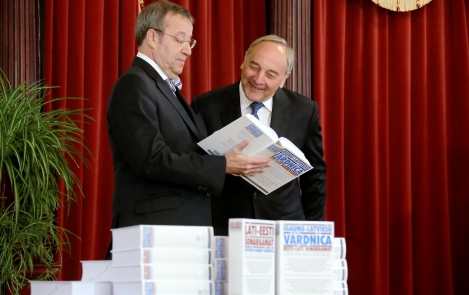-
Reset
+


Presidents Ilves and Bērziņš represented Estonian-Latvian and Latvian-Estonian dictionaries
11.05.2015
Presidents Toomas Hendrik Ilves and Andris Bērziņš acknowledged the years of work done by the Latvian Language Agency and the Institute of Estonian Language that has resulted in the compilation of modern Estonian-Latvian and Latvian-Estonian dictionaries.
"The Livonians did beat us to it and compiled a Livonian-Estonian-Latvian dictionary back in 2012, as we were only making plans," told President Ilves today in Riga, at the first presentation of the dictionaries.
Our dictionaries, for two nations that lead close lives, were updated but were not comprehensive, he admitted, with the Estonian-Latvian/Latvian-Estonian dictionary drawn up by Karl Aben almost half a century ago still being used.
I do hope now that the number of people speaking Latvian – or at least those interested in the language – will increase in Estonia and the number of people interested in the Estonian language will start to rise in Latvia, told President Ilves.
The Estonian and Latvian heads of state were strong supporters and promoters of the new, modern dictionaries.
Within the framework of Estonian-Latvian cross-border co-operation programme, the Latvian Language Agency compiled the Estonian-Latvian Dictionary and the Institute of Estonian Language the Latvian-Estonian Dictionary; both editions include more than 40,000 entries. Apart from hard copies, the Institute of Estonian Language has published electronic versions of both dictionaries; the Latvian Language Agency has also made a full electronic version of its dictionary available online; soon this will be supplemented with mobile applications for the users of the Apple iOS and Android platforms.
The Latvian-Estonian dictionary, which was complied by the Institute of Estonian Language, was based on a bilingual parallel body of text, which was created by means of a third language; this is a unique method for the complication of a translation dictionary in Estonia. The structure, principles for compilation and automated layout were developed by Project Manager Arvi Tavast, and the translation and technology company Tilde took part in the compilation of the dictionary.
The Estonian-Latvian dictionary, which was complied at the Latvian Language Agency, was put together by Chief Editor Valts Ernštreits and Marika Muzikante and Maima Grīnberga; reviews were done by Guntars Godiņš and Lembit Vaba. This is a substantial and modern dictionary, which includes a good set of examples and grammatical information, and will help users both to translate from Estonian into Latvian and in learning the language. The dictionary includes an abundance of vocabulary that is most commonly used for the purposes of translation; many new Latvian words are published for the first time in this dictionary.
Everyone interested in the process of developing Estonian-Latvian dictionary is welcome to get involved, as modern technology has made the working version of the dictionary available for everyone. An updated version of the electronic Estonian-Latvian dictionary is now available online at www.ee-lv.lv, thanks to the Latvian Language Agency. Future plans include consistent improvement of the dictionary to enhance the level of translations in both Latvian and Estonian.
Office of the President
Public Relations Department




